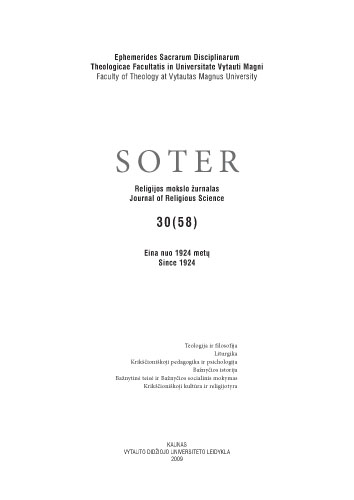Kauno dekanato parapijų padėtis XVII a. antrojoje pusėje
THE PARISHES OF KAUNAS DEANERY AT THE SECOND HALF OF THE 17TH CENTURY
Author(s): Vaida KamuntavičienėSubject(s): Christian Theology and Religion
Published by: Vytauto Didžiojo Universitetas
Keywords: bažnyčia; parapija; klebonas; vizitacija; brolija; prieglauda; mokykla; church; parish; parish priest; visitation; confraternity; alms-house; school
Summary/Abstract: The article discusses activities and material well-being of Kaunas deanery churches at the second half of the 17th century. The main sources of the study are church visitations from 1668-1669 (made on the initiative of Vilnius bishop Aleksandras Sapiega) and 1674-1676 (made on the initiative of Vilnius archdeacon Gratianopol bishop Mikalojus Slupskis) as well as inventories of certain churches from the second half of the 17th century. Severe consequences of the 1654-1667 wars with Russia and Sweden for the churches of Kaunas deanery are analyzed, material well-being of the churches and their altars discussed, priests of the churches, as well as spiritual, educational and charitable activities are described. According to the data of Vilnius Diocesan synod (1669), Kaunas deanery had the biggest number of parishes in Vilnius diocese. There were 17 parochial churches and 2 filial churches (filia) in Kaunas deanery: Kaunas, Kaunakiemis, Jieznas, Stakliškės, Aukštadvaris, Semeliškės, Žiežmariai, Žasliai, Paparčiai, Karmėlava, Lapės, Gegužinė, Skaruliai, Vandžiogala, Rumšiškės, Užuguostis (filial church of Stakliškės), Darsūniškis, Prienai, Birštonas (filial church of Prienai). Until 1654, there were only 5 parochial churches built of bricks in the deanery: Kaunas, Aukštadvaris, Skaruliai, Lapės and Paparčiai. All the other churches were wooden. All churches of Kaunas deanery were considerably devastated and their material well-being was almost totally destroyed during the wars of 1654-1667. 9 wooden churches were totally burnt down. After the war, priests were engaged in major repairs. Temporary churches similar to barns were built in the place of the destroyed ones (szoppa alias casa). During the 1660s and 1680s new wooden churches were built in Prienai, Stakliškės, Semeliškės, Žiežmariai, Žasliai and Rumšiškės, whereas in Jieznas and Kaunakiemis they were built of bricks. Parishes of Kaunas, Prienai and Stakliškės became the richest in Kaunas deanery. Temporary churches had only one altar. Bigger churches usually had three altars. The most popular in the deanery were the altars and paintings devoted to the Virgin Mary. This proves the historical fact that at the second half of the 17th century the cult of the Virgin Mary was widely spread in Vilnius diocese. The symbols of Trinity also were used. Among the saints, the most popular were St. Peter, St. Paul, St. Ann, St. Michael Archangel and others. Almost half of all the churches were under the patronage of the Ruler. In the lands of the Ruler, with his privity, noblemen often established foundations. The most famous supporters of the churches in Kaunas deanery were noblemen from the families of Lackiai (foundation of Aukštadvaris, Lapės and Užuguostis churches), Pacai (foundation of Jieznas church), Skorulskiai (foundation of Skaruliai church), Rostovskiai (foundation of Vandžiogala church) and Beinartai (foundation of Paparčiai church). The churches of Aukštadvaris (foundation by Jonas Alfonsas
Journal: SOTER: religijos mokslo žurnalas
- Issue Year: 58/2009
- Issue No: 30
- Page Range: 127-139
- Page Count: 13
- Language: Lithuanian

